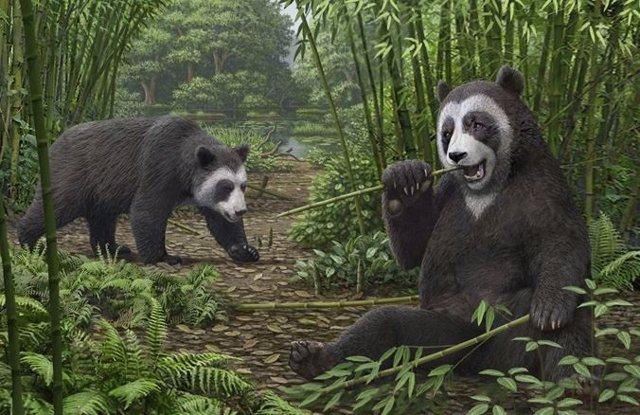An artistic reconstruction of Ailurarctos from Shuitangba. – MAURICIO ANTON.
June 30. () –
The first fossil evidence of a thumb-like sixth finger used by giant pandas and their ancestors to grasp bamboo indicate that bamboo was their diet as early as 6 million years ago.
In addition to the five digits on their hands, modern giant pandas (‘Ailuropoda melanoleuca’) they have an enlarged wrist bone with a thumb-like structure that they use to manipulate bamboo. Previous research documented the existence of this thumb-shaped structure as recently as 100,000 to 150,000 years ago.
Xiaoming Wang and colleagues at the Los Angeles County Xiaoming Wang Museum of Natural History examined the wrist bone of an individual of the ancestral panda genus Ailurarctos that was discovered at Shuitangbaa site near the city of Zhaotong, in the Chinese province of Yunnan, and dating from the late Miocene (approximately between six and seven million years ago).
As published in Scientific Reportscompared the shape and size of this bone with previously published data on the wrist bones of modern giant pandas and Indarctos arctoides, an ancient bear that lived nine million years ago and may share the same common ancestor as the giant pandas.
The researchers found that the modern giant panda’s thumb-like structure has the same distinctive shape as the Ailurarctos wrist bone, but not that of ‘I. arctoides’, which was larger, broader and more hooked.

This indicates that although the thumb-shaped sixth digit was not present in the ‘I. arctoides’ nor in the common ancestor it shares with pandas, it has been present in the panda lineage –and used to grasp bamboo– for at least six million years.
Although the sixth digit was present in both modern giant pandas and Ailurarctos, the researchers noted differences in its size and shape. The digit of the modern giant panda is significantly shorter than that of Ailurarctos relative to its body size and has a hook at its end. and a flattened outer surface, while that of Ailurarctos does not.
The authors propose that the hook may help modern pandas better grip bamboo, while the shorter length and flattened outer surface may help distribute weight when walking. These weight-bearing limitations could be the main reason why the giant panda’s thumb-like structure never evolved into a full digit, they add.













Add Comment